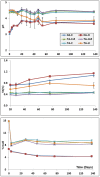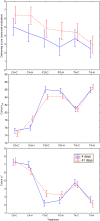Microbiological and Physicochemical Changes in Natural Green Heat-Shocked Aloreña de Málaga Table Olives
- PMID: 29167665
- PMCID: PMC5682407
- DOI: 10.3389/fmicb.2017.02209
Microbiological and Physicochemical Changes in Natural Green Heat-Shocked Aloreña de Málaga Table Olives
Abstract
Preserving the highly appreciated natural freshness of Aloreña de Málaga table olives and preventing their progressive darkening during processing is a major challenge. In this work, heat-shocked (60°C, 5 min) fruits were processed according to the three denominations referred to in the Protected Designation of Origen (cured, fresh green, and traditional) and their characteristics compared with those that followed the habitual industrial process (controls). The results revealed that the effects of the heat treatment on the evolution of pH, titratable acidity, salt, sugar, organic acid, ethanol content, texture, and color of fruits as well as on microbial populations (yeasts and lactic acid bacteria) were slight in the case of the fresh green and cured presentations. However, the differences between heat-shocked and its control were remarkable in the traditional process. Notably, the heat treatment favored lactic acid fermentation, retention of the green appearance of the fruits, stability during packaging, and led to the highest sensory evaluation. The metagenomic analysis carried out at the end of the fermentation revealed the presence in all samples of three genera (Lactobacillus, Pediococcus, and Celerinatantimonas) which encompassed most of the sequences. The number of Lactobacillus sequences was statistically higher (p ≥ 0.05) in the case of traditional heat-shocked fruits than in its control.
Keywords: heat treatment; metagenomic analysis; olive packaging; sensory evaluation; table olives.
Figures






References
-
- Argyri A. A., Nisiotou A. A., Mallouchos A., Panagou E. Z., Tassou C. C. (2014). Performance of two potential probiotic Lactobacillus strains from the olive microbiota as starters in the fermentation of heat-shocked green olives. Int. J. Food Microbiol. 171 68–76. 10.1016/j.ijfoodmicro.2013.11.003 - DOI - PubMed
-
- Arroyo-López F. N., Bautista-Gallego J., Durán-Quintana M. C., Garrido-Fernández A. (2008). Effects of ascorbic acid, sodium metabisulfite and sodium chloride on freshness retention and microbial growth during the storage of Manzanilla-Aloreña cracked table olives. LWT Food Sci. Technol. 41 551–560. 10.1016/j.lwt.2007.05.016 - DOI
-
- Arroyo-López F. N., Durán-Quintana M. C., Romero C., Rodríguez-Gómez F., Garrido-Fernández A. (2007). Effect of storage process on the sugars, polyphenols, color and microbiological changes in cracked Manzanilla-Aloreña table olives. J. Agric. Food Chem. 55 7434–7444. 10.1021/jf070571b - DOI - PubMed
LinkOut - more resources
Full Text Sources
Other Literature Sources

